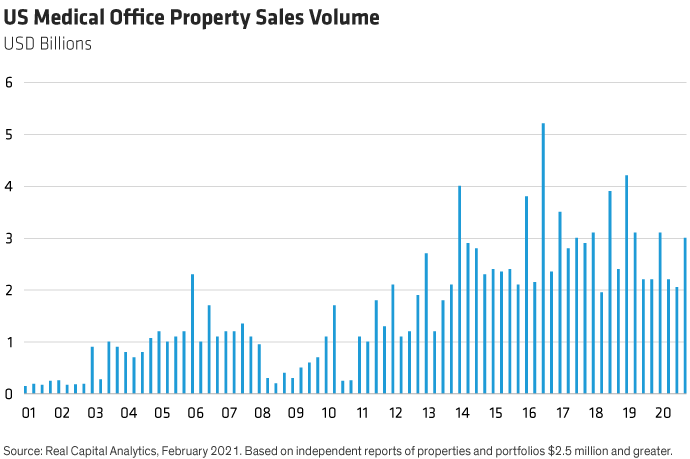Many medical practices are sitting on a hot commodity these days as a growing number of private investors and real estate investment companies seek out healthcare properties for their recession-resistant cashflows. Increased interest has sent medical office property sales—and their associated values—soaring (Display). But not every medical provider is ready to sell their practice just to capture the gain. Fortunately, medical practices that own their real estate have another option.

A sale and leaseback transaction may offer an opportunity to cash in on appreciated real estate and generate liquidity while continuing to operate and maintain control of the building. With a sale and leaseback, the practice sells its real estate—which is typically owned by a separate entity from the practice for legal and/or tax purposes—and enters a long-term lease with the buyer.
Sale-leasebacks provide numerous benefits to physician-owners. For instance, the arrangement allows them to generate cash from an illiquid asset while avoiding traditional mortgage financing. These transactions also reduce partnership buy-ins and help attract new physicians who may not wish to take on real estate ownership. They also improve the practice’s balance sheet—and potentially, the bottom line. New rent expense may be deductible to earnings, and at times, exceed the depreciation deduction available when the property was owned. Some physician-owners use the cash infusion from a sale to expand their practice, while others make distributions, allowing owners to build their liquid portfolio and shore up future retirement plans.
Weighing the Pros and Cons
What should physician-owners consider when faced with the opportunity to enter a sale-leaseback transaction?
1) What are you giving up?
Selling medical real estate comes with a loss of flexibility—both in terms of the rental agreement and physical office space. Once a lease agreement is locked in, practice owners are unable to renegotiate if the rental market declines, and their ability to transfer leasehold interests may be restricted.1 The practice also forfeits the option to remodel or modify the building without the new owner’s approval.
Another key trade-off? Missing out on the property’s potential appreciation. With that said, some acquiring real estate companies offer medical practitioners a stake in their real estate fund. This allows physician owners to participate in any future income and appreciation as the fund acquires more medical office buildings. In this case, practitioners benefit twice over—by crystallizing the current value of their real estate while effectively diversifying a portion of the proceeds in multiple medical practice buildings across the country.
2) Do the lease terms make sense for you and your practice?
Typical leaseback agreements can range from 7- to 15-year terms and are structured as a triple net lease (NNN). This means that the lessee is responsible for property taxes, maintenance, insurance, and other expenses. In negotiating the agreement, it’s important to align the conditions with the goals of your practice and to plan for the end of the lease term. For example, practices with a longer time horizon should consider incorporating renewal or repurchase options into the agreement to minimize renewal/relocation risks at the end of the lease term.
3) Are you working with the right professionals?
Begin by engaging professional advisors with expertise in medical real estate transactions. When negotiating a contract and lease, an experienced accountant and a medical real estate attorney will help you avoid common pitfalls and recognize opportunities, including the tax treatment for the transaction and the potential to defer tax.2
Physician-owners may also choose between working with a broker or directly engaging a medical real estate buyer. Remember, some buyers may offer the ability to directly roll a portion of the sale proceeds into new real estate investments, potentially deferring realized gains on the sale. When choosing a broker, keep in mind that professionals with a network of national buyers may generate more competition, potentially resulting in a higher sale price. In addition to determining the structure of the leaseback arrangement, there are several other important questions to ask:
- How and where will the property be marketed?
- How will a potential buyer’s reputation be validated?
- Will personal guarantees be required (or can they be avoided)?
- What fees and sales commissions are involved?3
All these professionals—including your financial advisor—should be involved each step of the way. They will know what to look for in an offer and how to explain its relevant parts. They are also better positioned to guide you through the pros and cons, and ultimately protect your interests.
Is a Sale-Leaseback Right for You?
You’ve surrounded yourself with experienced advisors, established a comfort level with the buyer, and ensured you understand the terms of the deal. Next, enlist your Bernstein Financial Advisor to dimension the financial benefit. He or she can leverage sophisticated modeling tools to help you make an informed decision. For instance, we can project how much liquid wealth you’re likely to have not only after the transaction, but 10, 20, or 30 years down the road. Some practitioners use this knowledge to gauge whether they will be financially ready to retire in a few years. Others find it sets a target for future liquidity events designed to meet their long-term goals.
Your financial advisor can also help you explore what to do with the proceeds, including strategies to diversify cash proceeds that span both traditional and alternative investments. The latter often take the form of private placements that offer attractive return potential while lowering overall portfolio risk. By analyzing your personal situation, your advisor can help align your goals with a transaction focused on optimal outcomes.
- Morgan Campbell
- Associate Director—Wealth Strategies Group
- Daniel Brunello, CFP
- Director—Wealth Strategies Group
1 https://blog.thebrokerlist.com/pros-and-cons-of-a-sales-leaseback/

